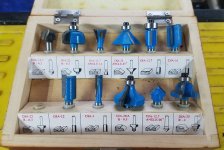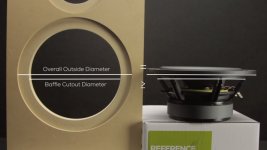7 ply is better. It will do.
More than a few have built out of solidn wood, but one really needs to know what they are doing.
At this point you just want to get something built, start enjoying the music, and get a base line of understanding for your next build. Once you build 1 it is hard not to want to do more.
dave
More than a few have built out of solidn wood, but one really needs to know what they are doing.
At this point you just want to get something built, start enjoying the music, and get a base line of understanding for your next build. Once you build 1 it is hard not to want to do more.
dave
Oh, I have no doubt about that! I'm already plotting out the center channel replacement, if this goes well.Once you build 1 it is hard not to want to do more.
How about damping for these? The instructions for the Bloodhound talk quite a bit about damping the manifolds (those are the partial 'walls' between the front and rear faces of the box, right?) and certain parts of the box with 1/2" Ultratouch felt or equivalent. Are we talking about this stuff? If so, I can't swing $60 just for sound damping material, what other options are there? I did find this, but it's 1" thick. Would that work with some adaptation?
I'm assuming that whatever we use must be considered acoustically transparent, since it's taking up considerable space in a fairly small enclosure?
Hi Elmojo,
I recently purchased this:
Amazon.com: New Level 12 Pack- Red/Charcoal Acoustic Panels Studio Foam Egg Crate 1" X 12" X 12": Musical Instruments
I've also used foam carpet underlayment as well. In light of the budget, sometimes we need to do the best we can for what we can afford.
Mike
I recently purchased this:
Amazon.com: New Level 12 Pack- Red/Charcoal Acoustic Panels Studio Foam Egg Crate 1" X 12" X 12": Musical Instruments
I've also used foam carpet underlayment as well. In light of the budget, sometimes we need to do the best we can for what we can afford.
Mike
Thanks Mike! That got me thinking, I saw on another thread that those magic eraser foam blocks could be used. Would that work here, or wrong application?
I can get a huge pack of 50 for about $10.
I can get a huge pack of 50 for about $10.
The more I look at options, I really think this is maybe my best choice, unless you guys see a reason why it won't work? It's cheap, safe, and seems to be the same material as the Ultratouch material mentioned in the instructions for the Bloodhound.
Thanks Mike! That got me thinking, I saw on another thread that those magic eraser foam blocks could be used. Would that work here, or wrong application?
I can get a huge pack of 50 for about $10.
I don't know anything about the magic erasers. Are they impregnated with anything? For the price, it might be worth trying if you can get to the inside of the cabinet to change if they don't work well.
The more I look at options, I really think this is maybe my best choice, unless you guys see a reason why it won't work? It's cheap, safe, and seems to be the same material as the Ultratouch material mentioned in the instructions for the Bloodhound.
That looks good to me. I might even order some. Looks like a good value to me.
The 1st ultraTouch link is for the wall insulation, you are looking for the felt. The 2nd link is exactly, except for the thickness, what you are looking for. simialr can be had in the specified thickness sold as hot water heater blanket material with a thin foil layer on one side and as an hvac silencing matriel with a then black layer on one side. The 1st might be available in small quantities, the 2nd maybe not (i bought in 100 foot rolls).
The 2nd could be used as is, but you might find more bass attenuation than desirable, I have seen where X described the magic erasers and if true they would work… i figured it would be worth buying some to experiemnt with. but given he was the one who’s recommendation had me try the dissapointing TC9 i always take his results with a grain of salt — he has done some very good work thou (his practical implementation of a highly tapered half-wave TL for midTweeters for instance, the dagger).
Carpet underlay, if (mostly) natural works well, as an example many early cars (50s-80s?, newer?) are a good source, specialty felts are usually kinda pricey. Poly batting, fiberglass insulation and others work well too. Avoid foam.
And as Mike said
Scronge.
dave
The 2nd could be used as is, but you might find more bass attenuation than desirable, I have seen where X described the magic erasers and if true they would work… i figured it would be worth buying some to experiemnt with. but given he was the one who’s recommendation had me try the dissapointing TC9 i always take his results with a grain of salt — he has done some very good work thou (his practical implementation of a highly tapered half-wave TL for midTweeters for instance, the dagger).
Carpet underlay, if (mostly) natural works well, as an example many early cars (50s-80s?, newer?) are a good source, specialty felts are usually kinda pricey. Poly batting, fiberglass insulation and others work well too. Avoid foam.
And as Mike said
.In light of the budget, sometimes we need to do the best we can for what we can afford.
Scronge.
dave
Thanks so much guys.
Orders placed for the drivers, cotton insulation and terminals.
I'll pick up the plywood tomorrow. I have wood glue, screws and finish already.
I think I'll have about what I need to complete this project once the packages arrive!
What's the best way to cut the holes, bevels and recesses for the drivers to sit in?
Looking at the plans for the Bloodhound, it appears that it requires a fairly complex profile. I have a router, but it's table mounted. I can't quite wrap my head around how I'd set up a template or guide for cutting this part.
Orders placed for the drivers, cotton insulation and terminals.
I'll pick up the plywood tomorrow. I have wood glue, screws and finish already.
I think I'll have about what I need to complete this project once the packages arrive!
What's the best way to cut the holes, bevels and recesses for the drivers to sit in?
Looking at the plans for the Bloodhound, it appears that it requires a fairly complex profile. I have a router, but it's table mounted. I can't quite wrap my head around how I'd set up a template or guide for cutting this part.
The best way to do holes, bevels, and recesses is with a router. If you can't remove your router from the table, you can use a hole saw or a jigsaw for the driver hole. A 45-degree chamfer bit on your router will take care of the bevels. If you don't have a chamfer bit, a table saw or circular saw can be used for the bevels. I don't know how you can do a recess without removing you router from the table and using a circle jig. You can buy or DIY a circle jig. Make a DIY Circle Jig for a Router - House One
Last edited:
Thanks Mike, I'll check and see what's involved in pulling it from the table, and also what bits I have. I haven't used it in years so I can't recall off hand.
If you have a table saw or a good straight edge for a circular saw, that might be easier than using a router for the bevels. If you can't get it recessed, it's not the end of the world. It's much better if you can, but it isn't worth not building the speakers if you can't.
If you can't get it recessed, it's not the end of the world. It's much better if you can, but it isn't worth not building the speakers if you can't.
You can build up the baffle, even with some of the felt you are getting, if it becomes difficult to do a rebate.
https://frugal-phile.com/boxlib/markaudio/Alpair5.pdf
dave
I'm having trouble imagining how I'd cut a circular recess with a table saw or circular saw, both of which I have, by the way. Has anyone run across a tutorial, or better yet a video for this process?
That stumped me too.
I have often used a jigsaw, and just used a small router with no template to do rebates. Later i was not allowed to build cabinets.
dave
I have often used a jigsaw, and just used a small router with no template to do rebates. Later i was not allowed to build cabinets.
dave
The saw is for the bevel.
Still a mystery. How do you do the 45° bevel on the back of the driver cutout was a saw (can be crudely dne with a jigsaw, but a big-assed rasp works better, faster, with more control.
dave
Still a mystery. How do you do the 45° bevel on the back of the driver cutout was a saw (can be crudely dne with a jigsaw, but a big-assed rasp works better, faster, with more control.
dave
I'm referring to the bevel on the outer edges of the cabinet, such as the classic golden ratio has. For the chamfer inside the cabinet in the speaker hole, a router or rasp works.
Later i was not allowed to build cabinets.

 A genuine LOL, I love it!
A genuine LOL, I love it!a big-assed rasp works better, faster, with more control.
Well, I do happen to have a B.A.R. in my shop, so that may be the weapon of choice if I don't have a chamfer bit in my router box. I'm gonna go look here in a minute. Does it not tear up the layers of the plywood? I assume you have to cut 'with the grain' so to speak, but still... Let me go see if I have that router bit, it sure would make this all a moot point, wouldn't it?
To clarify, what exactly is the rebate? Is that the bevel on the back side of the front baffle, or the recess that the driver sits down into on the front face?
EDIT: Yep, I have a decent set of bits, including a 45-degree chamfer. I shouldn't have any trouble cutting the holes, assuming I can figure out a way to do the circles cleanly.
Attachments
Last edited:
- Home
- Loudspeakers
- Full Range
- Suggestions for complete newb - PC/desktop speakers?

